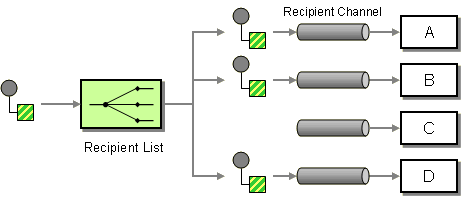A Content-Based Router allows us to route a message to the correct system based on message content. This process is transparent to the original sender in the sense that the originator simply sends the message to a channel, where the router picks it up and takes care of everything.
In some cases, though, we may want to specify one or more recipients for the message. A common analogy are the recipient lists implemented in most e-mail systems. For each e-mail message, the sender can specify a list of recipients. The mail system then ensures transport of the message content to each recipient. An example from the domain of enterprise integration would be a situation where a function can be performed by one or more providers. For example, we may have a contract with multiple credit agencies to assess the credit worthiness of our customers. When a small order comes in we may simply route the credit request message to one credit agency. If a customer places a large order, we may want to route the credit request message to multiple agencies and compare the results before making a decision. In this case, the list of recipients depends on the dollar value of the order.
In another situation, we may want to route an order message to a select list of suppliers to obtain a quote for the requested item. Rather than sending the request to all vendors, we may want to control which vendors receive the request, possibly based on user preferences
How do we route a message to a list of dynamically specified recipients?

Define a channel for each recipient. Then use a Recipient List to inspect an incoming message, determine the list of desired recipients, and forward the message to all channels associated with the recipients in the list.
The logic embedded in a Recipient List can be pictured as two separate parts even though the implementation is often coupled together. The first part computes a list of recipients. The second part simply traverses the list and sends a copy of the received message to each recipient. Just like a Content-Based Router, the Recipient List usually does not modify the message contents.
... Read the entire pattern in the book Enterprise Integration Patterns
Related patterns:
Aggregator, Scatter-Gather, Introduction to Composed Messaging Examples, Content-Based Router, Dynamic Router, Message Filter, Idempotent Receiver, Message Router, Selective Consumer, Point-to-Point Channel, Publish-Subscribe Channel





